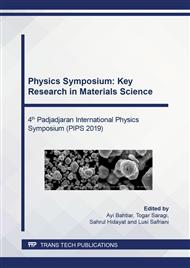[1]
V. Skumryev, S. Stoyanov, Y. Zhang, G. Hadjipanayis, D. Givord, J. Nogues, Beating the superparamagnetic limit with exchange bias, Nature 423 (2003) 850-853.
DOI: 10.1038/nature01687
Google Scholar
[2]
S. Prijic, G. Sersa, Magnetic nanoparticles as targeted delivery systems in oncology, Radiol. Oncol. 45 (2011) 1–16.
DOI: 10.2478/v10019-011-0001-z
Google Scholar
[3]
A.R. Kiasat, J. Davarpanah, Fe3O4@silica sulfuric acid nanoparticles: An efficient reusable nanomagnetic catalyst as potent solid acid for one-pot solvent-free synthesis of indazolo [2,1-b] phthalazine-triones and pyrazolo [1,2-b] phthalazine-diones, J. Mol. Catal. A-Chem. 373 (2013) 46–54.
DOI: 10.1016/j.molcata.2013.03.003
Google Scholar
[4]
H. Sun, X. Zeng, M. Liu, S. Elingarami, G. Li, B. Shen, N. He, Synthesis of size-controlled Fe3O4@SiO2 magnetic nanoparticles for nucleic acid analysis, J. Nanosci. Nanotechnol. 12 (2012) 267–273.
DOI: 10.1166/jnn.2012.5170
Google Scholar
[5]
C. Li, C. Ma, F. Wang, Z. Xil, Z. Wang, Y. Deng, N. Preparation and biomedical applications of core-shell silica/magnetic nanoparticle composites, J. Nanosci. Nanotechnol. 12 (2012) 2964–2972.
DOI: 10.1166/jnn.2012.6428
Google Scholar
[6]
M. Abbas, B. Parvatheeswara Rao, Md. Nazrul Islam, S. M. Naga, M. Takahashi, C. Kim, Highly stable-silica encapsulating magnetite nanoparticles (Fe3O4/SiO2) synthesized using single surfactantless-polyol process, Ceram. Int. 40 (2014) 1379–1385.
DOI: 10.1016/j.ceramint.2013.07.019
Google Scholar
[7]
S. Laurent S., D. Forge, M. Port, A. Roch, C. Robic, L. Vander Elst, R.N. Muller, Magnetic iron oxide nanoparticles: Synthesis, stabilization, vectorization, physicochemical characterizations, and biological applications, Chem. Rev. 108 (2008) 2064–2110.
DOI: 10.1021/cr068445e
Google Scholar
[8]
J.L. Dormann, D. Fiorani, E. Tronc, Magnetic relaxation in fine-particle systems, Adv. Chem. Phys. 98 (1997) 283-494.
DOI: 10.1002/9780470141571.ch4
Google Scholar
[9]
R.H. Kodama, Magnetic nanoparticles, J. Magn. Magn. Mater. 200 (1999), 359-372.
Google Scholar
[10]
G.F. Goya, M.P. Morales, Field dependence of blocking temperature in magnetite nanoparticles, J. Meta. Nanocryst. Mater. 20-21 (2004) 673-678.
DOI: 10.4028/www.scientific.net/jmnm.20-21.673
Google Scholar
[11]
Georgia C. Papaefthymiou, Nanoparticle magnetism, Nano Today, 4 (2009) 438-447.
Google Scholar
[12]
D.A. Balaev, S.V. Semenov, A.A. Dubrovskiy, S.S. Yakushkin, V.L. Kirillov, O.N. Martyanovc, Superparamagnetic blocking of an ensemble of magnetite nanoparticles upon interparticle interactions, J. Magn. Magn. Mater. 440 (2017) 199-202.
DOI: 10.1016/j.jmmm.2016.12.046
Google Scholar
[13]
T. Saragi, N. Syakir, T. H. Nainggolan, C. Alboin, Risdiana, The effect of molar composition of Co2+ to structure and magnetic properties of CoFe2O4, AIP Conf. Proc. 1554 (2013) 123-125.
DOI: 10.1063/1.4820300
Google Scholar
[14]
T. Saragi, L.D. Busrifa, S. Butarbutar, B. Permana, Risdiana, The impact of synthesis temperature on magnetite nanoparticles size synthesized by co-precipitation method, IOP Conf. Series: J. Phys.: Conf. Ser. 1013 (2018) 012190 (4 pages).
DOI: 10.1088/1742-6596/1013/1/012190
Google Scholar
[15]
T. Saragi, B. Permana, M. Safitri, L.D. Busrifa, S.W. Butarbutar, L. Safriani, I. Rahayu, Risdiana, The Effect of pH and sintering treatment on magnetic nanoparticles ferrite based synthesized by coprecipitation method, J. Phys.: Conf. Ser. 1080 (2018) 012019 (5 pages).
DOI: 10.1088/1742-6596/1080/1/012019
Google Scholar
[16]
T. Saragi, B. Permana, A. Therigan, S. Hidayat, N. Syakir, Risdiana, Physical properties of encapsulated iron oxide, Mater. Sci. Forum 966 (2019) 277-281.
DOI: 10.4028/www.scientific.net/msf.966.277
Google Scholar
[17]
S. Hong, Y. Chang, I. Rhee, Chitosan-coated ferrite (Fe3O4) nanoparticles as a T2 contrast agent for magnetic resonance imaging, J. Korean Phy. Soc. 56 (2010) 868-873.
DOI: 10.3938/jkps.56.868
Google Scholar


